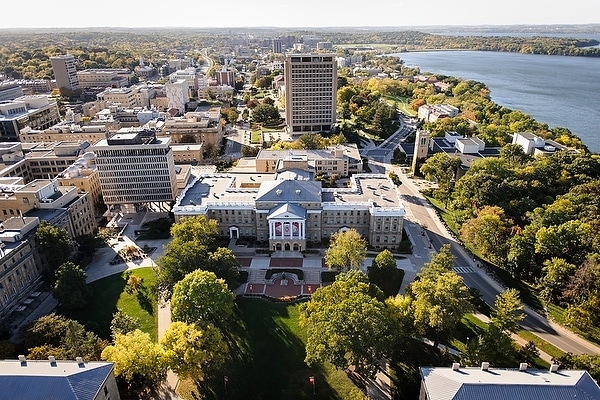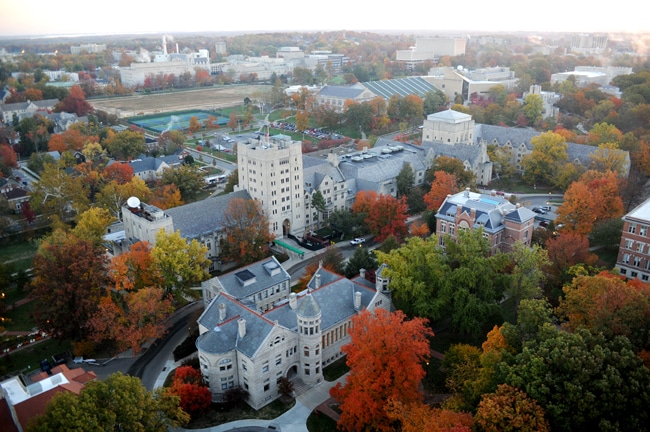
10 Renowned Language Schools in the US: Middlebury, Stanford and More
The new ways that are popping up to learn languages online are pretty exciting.
But if you’re going to learn a language in a more formal way, there are worse places to do it than a college campus—experienced teachers, motivated classmates and piles of easy-to-access resources are all in one place!
Here’s what you should know when picking a college to study a foreign language, including what to pay attention to when making your decision and recommendations of some of the best language schools in the US to get you started.
Contents
- Colleges with the Best Foreign Language Programs
- Alternatives to College Courses
- And One More Thing...
Download: This blog post is available as a convenient and portable PDF that you can take anywhere. Click here to get a copy. (Download)
Colleges with the Best Foreign Language Programs
1. Middlebury College
Location: Middlebury, Vermont
Middlebury is well-known among language learners for its Language Schools, which provide an intensely immersive summer language learning environment.
Based on that, you might expect Middlebury College proper to be a good place to learn a language, and the school doesn’t disappoint. Their first-rate program covers 11 languages: Arabic, Chinese, French, German, Hebrew, Italian, Japanese, Korean, Portuguese, Russian and Spanish.
It also includes partnerships with the Monterey Institute of International Studies, where you can complete an accelerated Middlebury/Monterey BA/MA, and the Middlebury C.V. Star Schools Abroad, where you can take your language studies overseas.
2. University of California, Los Angeles
Location: Los Angeles, California
UCLA isn’t just a big school in a major U.S. city. It’s also a language learning hub.
They offer a diverse array of languages that would make most language departments green with envy. Thought you couldn’t study Armenian, Quechua, Uzbek and Yoruba in college? Turns out you were wrong!
Their Center for World Languages provides a rich collection of language learning resources, including everything from an online database of learning material for 150+ “less commonly taught languages” to an Italian library and foreign language teaching workshops.
And because second language acquisition is one of the Center for World Languages’s research focuses, innovative language learning techniques are always making their way into UCLA’s classrooms.
3. University of Wisconsin–Madison
Location: Madison, Wisconsin
By the numbers alone, UW-Madison produces more language majors a year than any other U.S. university. During their time at the school, these students have access to an impressive collection of language learning resources, including classes in over 40 languages and study abroad programs with ties to over 60 countries.
UW-Madison boasts an impressive 26 conversation tables that meet regularly during the school year, so you can have casual conversations outside of class in a relaxed environment.
There’s also the Language Institute, a center for research, career advising, interdisciplinary studies and the federally funded Russian Flagship Program.
4. Cornell University
Location: Ithaca, New York
Cornell offers classes in languages ranging from Akkadian to Zulu. Altogether, there are 52 languages offered, including 31 that can be taken for at least two years.
The school’s Language Resource Center is home to a media library as well as a language lab. It also hosts talks related to language learning, many with an interdisciplinary bent.
In the past, a distinguishing aspect of Cornell has been its immersion programs in Asian languages, most recently its summer Mandarin intensive. Although the future of these offerings is unclear, Cornell’s language program in general remains very strong.
5. Harvard University
Location: Cambridge, Massachusetts
It’s no Middlebury, but Harvard still isn’t too shabby. Case in point: It has courses in 80+ languages, more than any other U.S. college.
The school’s Language Resource Center has a space for watching international TV (armchairs included!), screening rooms and a computer center. And if these on-campus resources aren’t enough, you can also get a discounted Rosetta Stone subscription through the school.
6. Indiana University
Location: Bloomington, Indiana
Indiana teaches a dazzling array of foreign languages and has the Center for Language Technology, which puts together regular workshops, conversation hours and festivals for language learners.
The school also hosts more Language Flagship Programs than any other U.S. university—programs that combine one-on-one tutoring, group instruction, immersive environments and interdisciplinary work to help students reach ACTFL Superior proficiency within four years.
7. University of Pennsylvania
Location: Philadelphia, Pennsylvania
Like other top language schools, University of Pennsylvania offers a competitive selection of languages.
More unique to the program is the Penn Language Center. Through the center, you can request a language tutor or become one yourself, and you can take proficiency assessments.
If you have an interest in sign language, business or medical professions, you can also sign up for specialized language courses in those areas.
8. Stanford University
Location: Stanford, California
Stanford stresses that because their program is all about becoming proficient, it emphasizes “doing rather than knowing.” Much of this happens with the help of the Digital Language Lab, which administers spoken and written tests—including the Simulated Oral Proficiency Interviews students take to graduate.
Stanford students also have easy access to a rich array of study abroad opportunities, and 50 percent (!) of Stanford students have studied overseas by the time they graduate.
9. University of California, Berkeley
Location: Berkeley, California
Besides taking courses and potentially majoring in one of almost 70 languages, students at UC-Berkeley can supplement their studies with a minor in Applied Languages to gain an understanding of how people learn languages and how languages interact with their broader cultural context.
Meanwhile, the Berkeley Language Center is a dynamic hub of learning and research. Some of the center’s activities include publishing a journal, putting on a series of workshops and curating a collection of foreign language film clips for students.
10. Yale University
Location: New Haven, Connecticut

Unlike its rival Harvard, Yale offers a mere 53 languages. But foreign language students at Yale aren’t left out in the cold. The Center for Language Study runs a thriving tutoring program and courses in special purpose languages like medical Chinese and medical Spanish.
Plus, if the language you’re interested in isn’t one of the 53, you can apply to receive up to four semesters of funding and support for outside study through the Directed Independent Language Study program.
Alternatives to College Courses
Ever wish you were in college again?
That’s okay! While it’s true that many of the features that make these programs unique are only accessible to students enrolled full-time in the schools, in many cases elements of the program will also be open to the public. Look into all of the following possibilities:
- Can you audit a course or take a summer course?
- Are there special courses like summer immersion programs that are open to the public?
- Are some of the services provided through the language program, like workshops, non-credit courses and digital tools, open to the public?
- Can you take distance learning or extension classes?
Alternatively, you could look into massive open online courses, or MOOCs, which are college-like courses available to the general public online. For a more traditional classroom experience give edX a go, while Coursera is great for flexible online learning.
There’s also resources like FluentU, an immersive language experience that lets you determine your own learning path its various features.
FluentU takes authentic videos—like music videos, movie trailers, news and inspiring talks—and turns them into personalized language learning lessons.
You can try FluentU for free for 2 weeks. Check out the website or download the iOS app or Android app.
P.S. Click here to take advantage of our current sale! (Expires at the end of this month.)

Ready to get back to school?
In the end, if you know what your priorities are, keep an open mind and do your research, you probably won’t go wrong.
Download: This blog post is available as a convenient and portable PDF that you can take anywhere. Click here to get a copy. (Download)
And One More Thing...
If you dig the idea of learning on your own time from the comfort of your smart device with real-life authentic language content, you'll love using FluentU.
With FluentU, you'll learn real languages—as they're spoken by native speakers. FluentU has a wide variety of videos as you can see here:
FluentU has interactive captions that let you tap on any word to see an image, definition, audio and useful examples. Now native language content is within reach with interactive transcripts.
Didn't catch something? Go back and listen again. Missed a word? Hover your mouse over the subtitles to instantly view definitions.
You can learn all the vocabulary in any video with FluentU's "learn mode." Swipe left or right to see more examples for the word you’re learning.
And FluentU always keeps track of vocabulary that you’re learning. It gives you extra practice with difficult words—and reminds you when it’s time to review what you’ve learned. You get a truly personalized experience.
Start using the FluentU website on your computer or tablet or, better yet, download the FluentU app from the iTunes or Google Play store. Click here to take advantage of our current sale! (Expires at the end of this month.)














